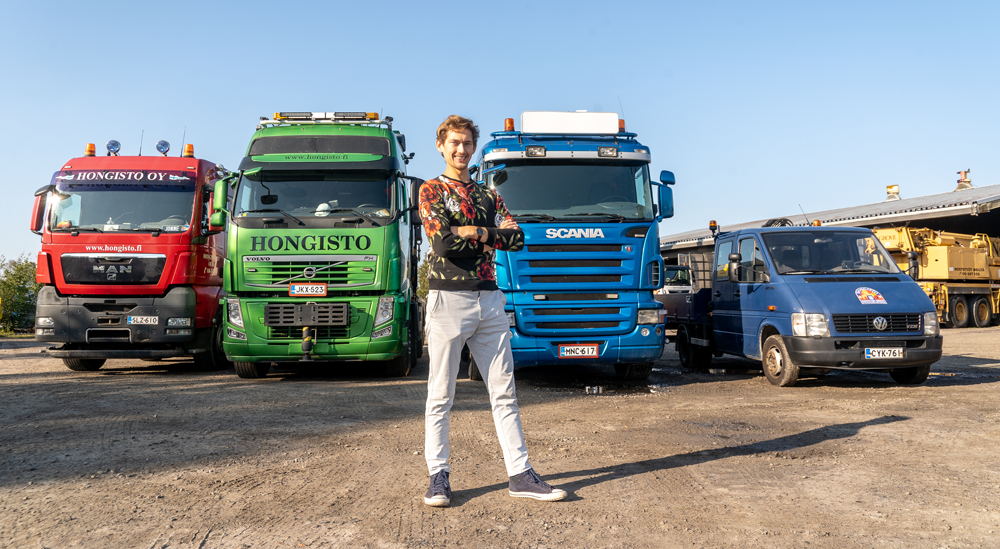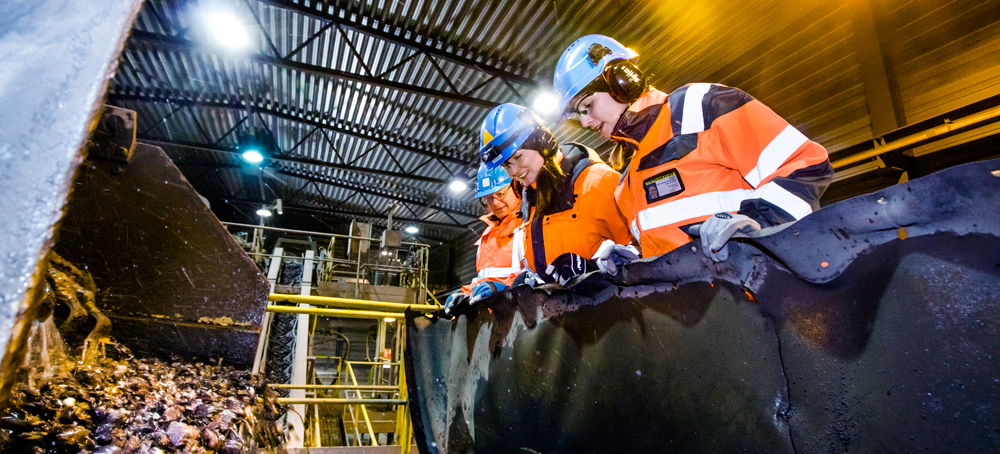
Three different INFRA member companies, three perspectives on how to reduce the carbon footprint. Hongisto, Tapojärvi and Kreate tell what they have done.
TEXT: SAIJA SYVÄOJA PHOTOS: HONGISTO OY, TAPOJÄRVI OY
INFRA FIELD it may be difficult for an entrepreneur to do all the things to reduce his carbon dioxide emissions, but everyone can do something. Often, ecological operation is also advantageous for the company, and it can be a competitive advantage in the industry's market.
Hongisto Oy – diesels for exchange
Hongisto Oy is a family business from Oulu, founded in 1954. The main field of the company is comprehensive lifting services, rental of vehicle cranes and special transport services
"Our equipment includes vehicle cranes from 30 to 200 tons, reachers, personal lifts and special transport vans as well as other trailers", the father of the "infrastructure company to be carbon neutral" idea Sakari Yrjö-Koskinen tells. Sakari is a partner of Hongisto Oy and an entrepreneur in the third generation.
"I had been thinking about how to reduce our company's greenhouse emissions for a long time. As a result of a long discussion, we switched to Neste's renewable MY diesel. It was the most direct solution to emission reductions."
"Furthermore, we have planned to completely change the lighting in the production facilities to LED lights and we are committed to compensating emissions with forest plantings," adds Sakari.
Most of the greenhouse emissions of a lifting company are caused by fuels. Hongisto's fleet uses a total of approximately 75 liters of diesel and fuel oil each year. This amount corresponds to approximately 000 million kilometers driven by a passenger car. About 10 tons of greenhouse gas emissions are produced annually.
Hongisto Oy replaces all the fossil diesel it uses with Neste MY, approximately 25 liters annually. Neste MY renewable diesel is made 000% from waste and residues.
 Hongiston's Sakari Yrjö-Koskinen wants to encourage companies in the infrastructure sector to participate in climate talks.
Hongiston's Sakari Yrjö-Koskinen wants to encourage companies in the infrastructure sector to participate in climate talks.
When switching to diesel, our emissions are reduced by approximately 25 percent of the total amount of carbon dioxide produced by the fuels. On top of this, the amount of energy purchased for electricity is reduced by about 80 percent as a whole with LED lighting.
Sakari sees that in climate talks, incentives are more attractive and binding in the long run than coercive bureaucracy or legal articles.
"Consumers must be given information about the carbon footprint of infrastructure products and services, as is already the case for some foodstuffs. This would be one marketing tool for companies that have woken up", Sakari reflects.
"If entrepreneurs had an obligation to report carbon dioxide emissions, the customer could compare the environmental friendliness of the products themselves."
The change in a more environmentally friendly direction is not free.
"Renewable diesel costs us about 5 euros more per year, but it is in line with our values and we must take quick steps against climate change."
"Congratulations to the government that fuel taxation could be more encouraging. For example, the bio-components of the state-majority Neste's renewable diesel could be taxed more lightly to make the use of renewable diesel more attractive. Now, for example, the price of MY diesel is 19 cents more expensive than normal diesel, not to mention the fuel consumption."
Kreate Oy – masses for circulation
Kreate Oy is one of Finland's largest infrastructure builders and the company employs a total of around 400 construction professionals. Kreate's turnover in 2018 was around 200 million euros.
Kreatella has its own environmental construction and circular economy unit, which is focused on environmental issues from the calculation of the offer to the implementation of the construction site.
"We aim for a mass balance on construction sites and always try to replace virgin materials with recycled or recycled materials. The aim is to use the surplus land on one's own or others' sites. Only then do we think about other utilization possibilities and final disposal locations", Kreate Oy manager Tuomo Joutsenoja says.
"Considering environmental issues in construction is a completely normal course of action for us and part of the site's environmental plan recorded in the site's operational systems."
The company's fleet is largely its own and meets the latest emission classification. The equipment is maintained on a regular basis and Kreate considers the environmental aspect in its purchases.
"We have the same quality and environmental requirements for subcontractors as for our own operations. The basic requirement is that you are capable of the same quality as us," continues Joutsenoja.
"As a tip for a company that is still thinking about environmental aspects in the operation of the company and the construction site. Minimize material surplus from the construction site. If there is material left, try to recycle it. Often the person who needs the material can be found nearby. Remember that long transport journeys always increase emissions."
Tapojärvi Oy – side streams back into production
Torniolainen Tapojärvi Oy works with the industrial circular economy. The company has around 500 employees and the company's turnover in the fiscal year that ended a year and a half ago was 115,7 million euros. Tapojärvi has a total of ten offices: eight in Finland, one in Sweden and one in Italy.
 In Tapojärvi, we want the industrial side streams back into production.
In Tapojärvi, we want the industrial side streams back into production.
"The leading company in material recycling means versatile operations in the field of mining and industrial services. We work in both underground mines and open pits, as well as steel mills as part of production. For example, at a steel factory, slag is processed and produced in order to minimize industrial by-products and at the same time get metals back into production," Tapojärven acting director. managing director Mari Pilventö clarify.
"We strive to take into account the entire value chain and utilize the side streams of production."
Tapojärvi is also thinking about the carbon footprint of the company's other operations.
"We were lulled into the fact that we do eco-deeds with our products, but we hadn't calculated the company's own carbon footprint. We already do many things with a low carbon footprint, but it has not actually been recorded as an operating method. However, we have used common sense and acted efficiently. Efficiency is often ecological," adds Mari Pilventö.
Heavy industry is usually thought of as a big emission bomb. It was a pleasant surprise for Tapojärvi to receive the Entrepreneur of the Year 2019 award, as the justification was: "Tapojärvi is a pioneer in the industrial circular economy." The company serves factories and mines, reducing the climate load and saving nature's virgin materials."
"Throughout our 64-year history, we have operated this way because it is reasonable, efficient and productive. It's great that ecology has also hit the headlines as a trend," says Mari Pilventö about the company's way of working.
"We invest in development and research what could be used from slag products and side streams in, for example, the chemical, paper and forestry industries. Sometimes we ourselves are surprised by it. It seems that only the sky is the limit as to how much nature could be saved by using materials that are already in circulation."
Something to think about emissions
- What is the condition of the machines and what kind of fuel do they use?
- Are any surplus materials recycled at your own or others' sites? Has waste recycling been taken care of at the construction sites?
- Could the use of recycled materials be increased on construction sites?
- Is the driving style of work machines monitored? Is the use of machines optimized and the right size class of machine used in each destination.
- Is the lighting and heating of the production facilities as environmentally friendly as possible? Has the waste been sorted?